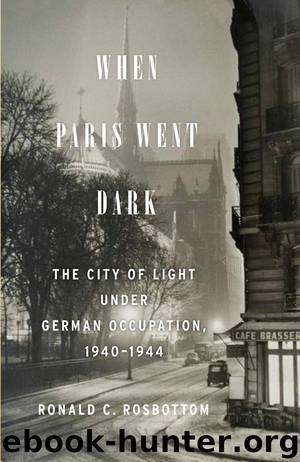When Paris Went Dark : The City of Light Under German Occupation, 1940-1944 by Rosbottom Ronald C

Author:Rosbottom, Ronald C. [Rosbottom, Ronald C.]
Language: eng
Format: mobi
Tags: History / Military / World War Ii, History / Europe / France, History / Jewish
Publisher: Hachette Book Group USA
Published: 2014-08-05T04:00:00+00:00
Finally, a coup de théâtre: on September 23, a small team managed to assassinate, in the cozy, German-preferred 16th arrondissement, General Dr. Julius Ritter, the head in Paris of the hated STO, which identified and drafted young French men between the ages of eighteen and twenty-two for forced work in Germany.
The Germans were caught off guard by this surge of violent attacks, and their troops were more and more demoralized as they watched “safe” Paris become a site for both discriminate and indiscriminate attacks against the Occupier. Enormous pressure was put on the French police, who created their infamous Brigades spéciales—about two hundred especially xenophobic and anti-Communist officers who volunteered to track down “terrorists” in the streets and neighborhoods of Paris. This office developed quite sophisticated means of following and setting up surveillance on suspected members of the underground. They were patient, even to the point of not stopping some attacks if they knew that bigger fish were still to be caught. They were experts in following their suspects, always working in twos and sometimes putting as many as four such teams on the heels of only one résistant. They disguised themselves as postal workers, bus drivers, even priests; one person caught in their snare reported that the team following him had even worn yellow stars! Once they arrested their suspects, they used the most brutal methods of interrogation, often to the embarrassment of their colleagues in other departments. After the war, many members of the Brigade spéciale were arrested, tried, found guilty, and put away for years, if not executed. In just a year, they managed to capture more than 1,500 young members of the Resistance, severely weakening the MOI.
When the MOI group was finally captured in November of 1943, after having been betrayed from within their ranks, they numbered twenty-three men and one woman. Interrogated and tortured for more than three months, they faced a hurried military trial, were found guilty, and were shot at the Mont-Valérien prison, outside Paris, in February of 1944. The one woman, Golda Bancic, a Romanian, was not allowed to die with her companions but was shipped to Germany, where she was decapitated in May of 1944.
Download
This site does not store any files on its server. We only index and link to content provided by other sites. Please contact the content providers to delete copyright contents if any and email us, we'll remove relevant links or contents immediately.
| Civilization & Culture | Expeditions & Discoveries |
| Jewish | Maritime History & Piracy |
| Religious | Slavery & Emancipation |
| Women in History |
Cecilia; Or, Memoirs of an Heiress — Volume 1 by Fanny Burney(31353)
Cecilia; Or, Memoirs of an Heiress — Volume 3 by Fanny Burney(30951)
Cecilia; Or, Memoirs of an Heiress — Volume 2 by Fanny Burney(30909)
The Secret History by Donna Tartt(16674)
Sapiens: A Brief History of Humankind by Yuval Noah Harari(13084)
Leonardo da Vinci by Walter Isaacson(11926)
The Radium Girls by Kate Moore(10922)
Sapiens by Yuval Noah Harari(4558)
The Wind in My Hair by Masih Alinejad(4429)
How Democracies Die by Steven Levitsky & Daniel Ziblatt(4423)
Homo Deus: A Brief History of Tomorrow by Yuval Noah Harari(4292)
Endurance: Shackleton's Incredible Voyage by Alfred Lansing(3856)
The Silk Roads by Peter Frankopan(3791)
Man's Search for Meaning by Viktor Frankl(3651)
Millionaire: The Philanderer, Gambler, and Duelist Who Invented Modern Finance by Janet Gleeson(3577)
The Rape of Nanking by Iris Chang(3530)
Hitler in Los Angeles by Steven J. Ross(3449)
The Motorcycle Diaries by Ernesto Che Guevara(3345)
Joan of Arc by Mary Gordon(3272)
